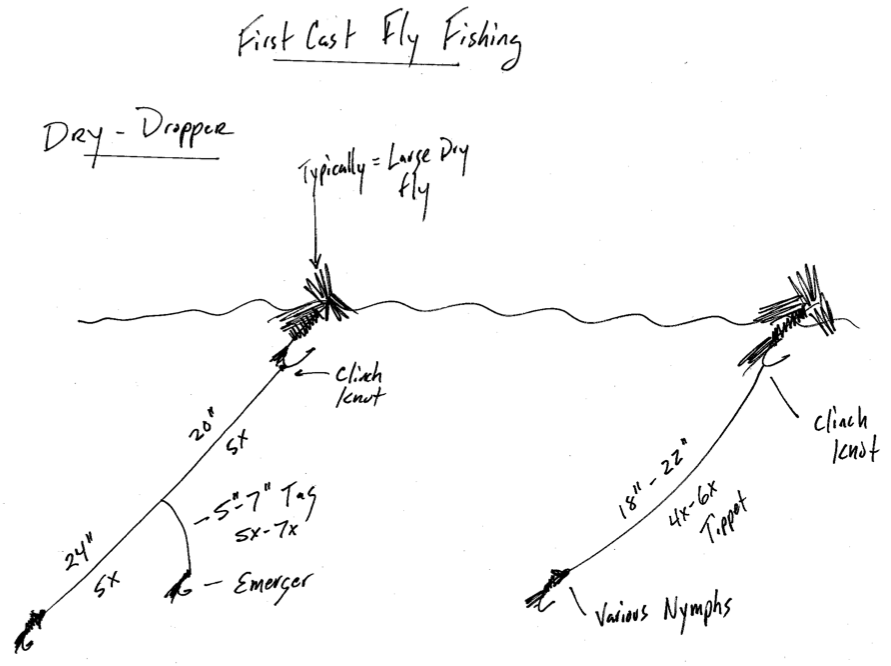How to use this blog? Use the blog search engine and type in key words such as Float Trip, Walk-Wade, Float Tube, Lessons, Pesos, Fy Rods, Lodging, Food, Wine, Flies, Best Months, etc. The search engine is located on the right side, just below the weather. FYI, there are over 100 post about fishing Patagonia...the information you are looking for, is probably on this blog. Thanks.
During peak summer months in Patagonia, the gold standard of fishing is the use of a dry-dropper rig. Whether you are walking-wading or floating, these rigs are extremely effective and easy to set-up. However, some anglers struggle with the set-up. I think they struggle because they don't know how or they doubt their abilities to attach tippet to the bend of the hook. When they attempt to attach the tippet, they use a technique that seems intuitive, but in real life application, it's awkward and not so efficient. To help you understand the techniques of adding a dropper, the goal of this post is to compare two styles of tying a dropper to the bend of the hook.
During peak summer months in Patagonia, the gold standard of fishing is the use of a dry-dropper rig. Whether you are walking-wading or floating, these rigs are extremely effective and easy to set-up. However, some anglers struggle with the set-up. I think they struggle because they don't know how or they doubt their abilities to attach tippet to the bend of the hook. When they attempt to attach the tippet, they use a technique that seems intuitive, but in real life application, it's awkward and not so efficient. To help you understand the techniques of adding a dropper, the goal of this post is to compare two styles of tying a dropper to the bend of the hook.
What is a dry-dropper rig? The below drawing shows that a dry-dropper rig is nothing more than a dry fly and trailing nymph(s). The dry fly has two roles in this set-up:
- You may catch a fish with the dry fly.
- A large dry-fly acts as your strike indicator or suspension device.
Personally, I have used this rig all over the world. Why? It catches fish! Technically, I am dry fly and nymph fishing at the same time (i.e. think surface and sub-surface feeding). In theory, the use of two flies increases my chances of catching fish (to a hungry fish, the combination of meat and potato's is hard to pass-up). If you are not using this set-up, I strongly encourage you to start using it ASAP. Experiment and see what happens.
 |
In the below video #1, I am demonstrating a technique that works, but is not the most efficient method of attaching a dropper to the bend. This technique seems highly intuitive, but in real life situations, it can be problematic. Things to be concerned about:
- Safety: The more time you spend holding the dry fly, the greater chance of sticking yourself.
- Hands: You must keep one hand on the fly at all times. Give it a try; you'll quickly understand why you wish you had a third hand.
- Line-Finger Control: The piece of tippet you are trying to wrap around the bend constantly slides off. To prevent this from happening, you must keep constant tension on the tippet, while it wrapped around the bend. Bottom line, it takes a great amount of hand-eye coordination to master this technique (beginners get easily frustrated).
- Knots: new improved clinch is possible, but it's tough and takes practice.
- Elements: Add in +20 mph wind and enjoy this humbling, awkward experience.
Video #1: Possible, but Inefficient Technique
The next diagram and video demonstrate an alternative dry-dropper technique. Things to note:
- Especially in video #1 technique, the use of clinch knot will enhance hand-eye coordination and make the process much easier/faster.
- Using an improved clinch knot is much easier in the video #2 technique.
- You don't have to use your finger. You might be able to use a gadget attached to your lanyard or vest. Just make sure this gadget does not damage the line.
- Before fishing, always test your knots; especially on a clinch knot. Attach the bend of the hook to a solid device (e.g. finger loop on your hemostat) and test your knot.
 |
| Another original master piece by Mark Foley :) |
Video #2: The Most Efficient Technique
Final Word
In both video's, I purposefully slowed down the instruction, or movement of my fingers. I also tried to show how the line does not always cooperate; especially utilizing the improved clinch knot. In time, and with practice/patience, your hand/finger coordination will greatly improve, and either technique will be performed much faster. If your hand/finger coordination does not improve, don't sweat it; slow and steady always wins the race. If you're like most anglers, eventually you'll favor video/technique #2.
Hope you found this post helpful.
Thanks,
Mark
